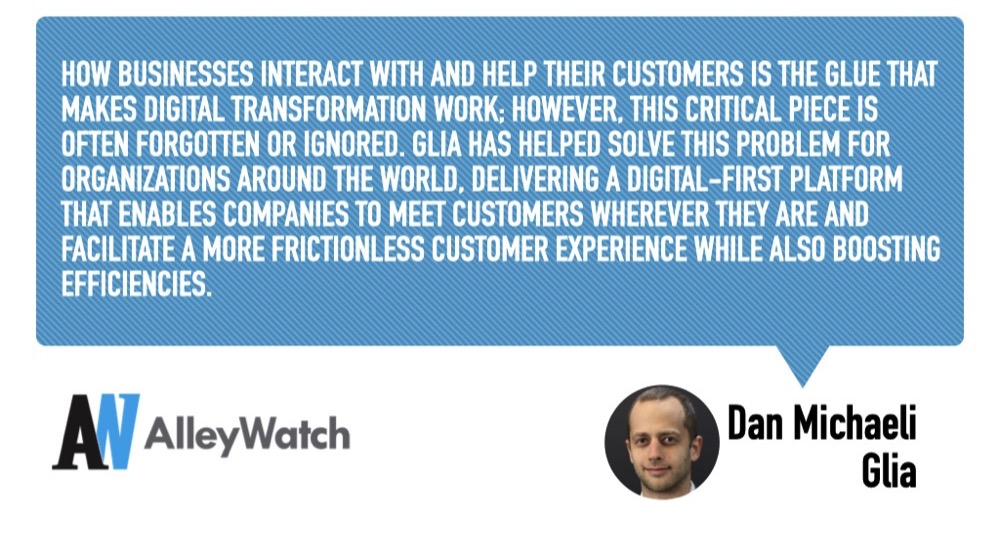The pandemic has amplified the importance of a robust digital customer service experience. Yet most solutions on the market provide a simple live chat function, which really does not adequately address the needs of today’s modern customers. Glia is a native digital customer service platform that allows consumers to interact with their choice of messaging, video, or even voice. The platform features the ability to collaborate with its CoBrowsing function that allows customers to get the help that they need while jointly navigating sites, eliminating any confusion or uncertainty. In the rush to digital transformation in 2020, Glia grew 150% and counts finance, insurance, and fintech companies like Berkshire Hathaway, United Healthcare, Deutsche Bank, Bank of the West/BNP Paribas as customers.
AlleyWatch caught up with CEO and Cofounder Dan Michaeli to learn more about how the platform enabled its partners to support customers during the lockdown, the company’s expansion plans, and recent funding round, which brings the total funding raised to $107M since the company’s founding in 2012.
Who were your investors and how much did you raise?
We raised $78 million in Series C funding led by existing investor Insight Partners.
Tell us about the product or service that Glia offers.
Glia is reinventing how businesses support their customers in a digital world. Our company believes that combining personalized live service with smart technology (like AI and machine learning) results in the best customer and employee experience. Our Digital Customer Service platform enriches web and mobile experiences with digital communication choices, on-screen collaboration, and AI-enabled assistance. By leveraging Glia’s solution, businesses can meet customers where they are and through whichever methods they prefer – including messaging, video, or voice – and guide them through CoBrowsing. The technology provides continuity by keeping conversations in the digital domain, eliminating the need for customers to spend time reauthenticating or providing context around their issue via clumsy phone-only experiences. With Glia’s modern technology, organizations are transforming their customer service models from a phone-centric to digital-centric approach, allowing them to more effectively serve the modern customer.
 What inspired the start of Glia?
What inspired the start of Glia?
While consulting for a Fortune 50 retailer, we identified that our client’s main competitive advantage was its superior in-person customer service. We wondered, “How can we replicate that same, winning experience online?”. At the time, digital was way behind the in-person customer experience. And so Glia was born.
We set out to build a unified Digital Customer Service platform from the ground up, with funding from supportive, tech-savvy investors. The result is a patented, visionary approach to Digital Customer Service that has earned many industry awards and praise from customers and analysts alike.
How is Glia different?
Glia has reinvented how businesses support their customers in a digital world by creating an entirely new category: Digital Customer Service. How businesses interact with and help their customers is the glue that makes digital transformation work; however, this critical piece is often forgotten or ignored. Glia has helped solve this problem for organizations around the world, delivering a digital-first platform that enables companies to meet customers wherever they are and facilitate a more frictionless customer experience while also boosting efficiencies. While there are other piecemeal customer service solutions in the industry, such as those that focus specifically on live chat, there is no platform as comprehensive as Glia. The company created a category unto itself, one that is broader and delivers more choice for the end-user than any other provider in the market.
What market does Glia target and how big is it?
Glia partners with financial institutions, insurance companies, and fintech providers across the globe. Digital Customer Service is poised to become the go-to solution for contact centers in the future – a market estimated to grow to over $25B by 2030.
What’s your business model?
Glia uses a standard cloud/SaaS yearly subscription model that includes a base fee and a per-user fee.
How has COVID-19 impacted your business?
This year in the midst of the pandemic, companies have reimagined how they support customers in a digital world, moving us to an era where there is a new model to service customers. With businesses temporarily closing branches, customers still require help as they leverage digital channels; now there’s an even bigger need for customer service and support as many consumers who have never leveraged digital channels are doing so now.
Answering that call can be a significant challenge for organizations, especially for companies without a continuity plan for unexpectedly distributed support staff and disruptions to contact center operations.
Fortunately, Glia’s platform is designed to facilitate location-independent, multichannel communications between enterprises and their consumers (including chat, phone, online voice and video). Many of our banking, insurance, and credit union customers are happy to find that they can quickly configure Glia to provide business continuity for displaced service workers and virtual contact center staff to keep the lines of communication open when the unthinkable happens.
Fortunately, Glia’s platform is designed to facilitate location-independent, multichannel communications between enterprises and their consumers (including chat, phone, online voice and video). Many of our banking, insurance, and credit union customers are happy to find that they can quickly configure Glia to provide business continuity for displaced service workers and virtual contact center staff to keep the lines of communication open when the unthinkable happens.
All in all, this helped accelerate what was already occurring in Digital Customer Service, helping us grow even faster than we had expected in 2020.
What was the funding process like?
Given the momentum for DCS, we were fortunate to have a lot of inbound interest from investors during our Series C. This empowered us to pursue the route which was most favorable for the business at this time (a financing from our existing investors in this case).
What are the biggest challenges that you faced while raising capital?
For this particular round we were fortunate to have a very smooth process with a lot of incoming interest from a variety of funds. The biggest challenge was selecting the right partner amongst the options that we had available to us.
What factors about your business led your investors to write the check?
Our fundamentals such as ARR growth and Net Retention are world-class. In addition, the Digital Customer Service place is experiencing an explosion across enterprises.
What are the milestones you plan to achieve in the next six months?
We are looking to increase our team by 40-50% and continue our rapid revenue growth trajectory.
What advice can you offer companies in New York that do not have a fresh injection of capital in the bank?
We’ve always thought very carefully about the investments that we make with our capital. In the Enterprise Software game, the challenge is stretching your time horizon as far out as possible as you iterate your solution with customers. Avoid frivolous spending and focus on where your dollars will make the biggest impact.
Where do you see the company going now over the near term?
We have established DCS as a category and now we are working to make it the standard for Customer Service.






